August 11, 2020
We spent the final day of our Great Tree Adventure Trip in Sequoia National Park. To give some perspective on where it is located, on the map below the black circle on the left is Fresno, the red circle is Sequoia National Park, the yellow circle is Mt. Whitney (located inside the national forest), and the blue circle is Death Valley.
The National Park Service arrowhead features a sequoia silhouette, and embossed sequoia cones, like the ones on the sign below, decorate the belts and hatbands of park rangers nationwide.
One tree, dubbed the "Mark Twain Tree," was cut in 1891. It was over 300 feet tall, substantially taller than the General Grant Tree. Slabs of its trunk still hang in New York and London museums.
I think when God create the Sequoias, he was experimenting with form, function, and humor.
The bark looks like ancient skin that has been carved and polished by the elements.
The final giant to whom we paid homage was The McKinley Tree, born around 100 BC--old, but still 1,100 years younger than The President Tree.
The obvious difference between Redwood and Sequoia National Parks is that being on the coast, Redwood National Park has a much more lush environment. For the novice, however, it is hard to see the difference between the redwood and sequoia trees themselves.
Perhaps the most significant difference for a lay person like me is that the giant sequoia has a huge trunk that tapers slightly as it rises, and the redwood, though it generally taller than the sequoia, has a more slender trunk. These are sequoias:
Another difference is that the sequoia's cones and seeds are about three times the size of those of the redwood.
The bark of the giant sequoia is reddish-brown, and the bark of the redwood is a dull chocolate brown, opposite of what you would think. Both woods are highly resistant to decay.
Our first stop in Sequoia National Park was The General Grant Grove, a 90-acre area in which a higher percentage of sequoias reach sizes of 10, 15, and 20 feet than in any other grove.
I took the two pictures below from the center of the tree looking first towards one side and then towards the other.
The star of the General Grant Grove is, of course, The General Grant Tree. The world's second-largest tree (by volume), it is 268 feet tall and 40 feet wide. That is about the height of a 24-story building! At just 1,700 years old, it is a youngster compared to its neighbor trees, some of which are as old as 3,000 years.
Sequoia NP is a little like Disneyland--there is one attraction after another. The first one we visited was this fallen tree with a path through the hollow trunk. We entered on the upper trunk side.
We exited through the roots.
In 1926, President Calvin Coolidge designated the General Grant Tree as the Nation's Christmas Tree, a role it has served every Christmas since then. No lights, no ornaments, just pure tree.
We noticed a LOT of trees that had fire damage, but signage reassured us that fire is a natural and needed factor in the life of a sequoia grove. The giants have thick insulating bark that protects the more vulnerable core. Sequoia wood is also high in tannin, a chemical that helps the burned wood resist rot and insects. Fire clears leaf litter and opens the cones, which then release their seeds in the bare soil. Areas cleared by fire are prime spots for young trees to grow.
A little burn at the ground-level of the colossal trees above doesn't seem to have stunted their growth. Here is what their tops look like:
Ironically, the other attraction in the Grant Grove is the shortest tree there, The Centennial Stump. According to signage at the site, early explorers returning to the East told of giant trees on the West Coast, but the public was skeptical. Some intrepid woodcutter finally chopped a few of them down, cut them into pieces, and shipped them east to exhibit them like freaks in a carnival show.
One of the butchered trees came from a spot not far from the General Grant tree. It was cut in 1875 for America's Centennial exhibition in Philadelphia. It took two men nine days to chop it down, and then a 16-foot section was cut from the trunk and hollowed out so it could be transported. However, even concrete (or wood, as it were) evidence was not enough for the Easterners, who did not believe it was a single tree and called it the "California Hoax." This is what that mighty tree looks like today--a sad-looking stump.
This tree on the left (below) looks like it might take off walking at any moment. There is something magical about the Sequoias that made me think of Tolkien's Treebeard (right).
Our next stop was The Sherman Tree Trail, a path that leads through The Giant Forest (so named by naturalist John Muir in 1875) to the eponymous Sherman Tree. The trail has a detour called the Congress Trail Loop.
John Muir described the Giant Forest in anthropomorphic terms, which is how I saw it as well. He said the Giant Forest is:
". . . a magnificent growth of giants grouped in pure temple groves, ranged in colonnades along the sides of meadows, or scattered among the other trees. . . . When I entered the sublime wilderness the day was nearly done, the trees with rosy, glowing countenance seemed to be hushed and thoughtful, as if waiting in conscious religious dependence on the sun, and one naturally walked softly and awe-stricken among them. I wandered on, meeting nobler trees where all were noble."
The General Sherman Tree is the largest tree on Earth (by volume). Some trees are bigger around, and some are taller, but no other tree has more wood in its trunk than this one. The top of the tree is dead, so it isn't getting any taller, but it continues to get wider--a very human characteristic!
It is impossible to get a photo of it, but the fence around the base gives some perspective as to the size.
A representation of the General Sherman Tree's "footprint" has been created next to it. It gives a pretty good idea of the enormous girth of the trunk--109 feet--as well as its irregular shape
Just as interesting as the macro world of the Giant Forest is the micro world. Check out this bizarre caterpillar/bug/insect. Does anyone know what it is?
Fire damage appears on a large percentage of the trees.
This fire scar, however, looks like it could be a portal to another world. It is incredible that the hollowed-out tree continues to thrive.
This portal was made by human hands, but be careful going through. Does it also lead to another world?
As we left General Sherman behind, we encountered a field of yellow coneflowers, perhaps the Sequoia equivalent of Dorothy's field of poppies in Oz.
Just as I was starting to feel drowsy, however, we came across this purple antidote, perhaps some kind of lupine?
We took the detour a started down The Congress Trail, a loop that leads to some VIPS and that had far fewer people than the path to The General Sherman Tree.
We rounded the corner and there he/she was! The President!
This venerable leader is almost 250 feet tall and 27 feet in diameter at the base. It is the third-largest tree in the world by volume, and at 3,200 years old, it is the oldest-known living sequoia! It is even older than President Biden! I think this was one of my favorite trees of all the sequoias. I love its lumpy, wrinkly base. It reminds me of an elephant foot.
Next up, The Senate, of course! This is a closely-growing cluster of six sequoias. They must all be from the same political party, otherwise they couldn't stand the close proximity.
We've posed for photos in representations of the Oval Office in various Presidential Libraries, but we have never posed with the SENATE before!
Onward.
The Giant Forest/Sherman Tree Trail is home to half of the Earth's largest and longest-living trees. Over 8,000 colossal sequoias grow in this relatively small area.
Of course, we knew this was coming--The House. Again, they must belong to the same political party. They look like they are having an intense discussion, perhaps about environmental legislation. (Would that make them Democrats?)
And further along the trail . . . if you want to be one with the forest, you must stand inside a tree.










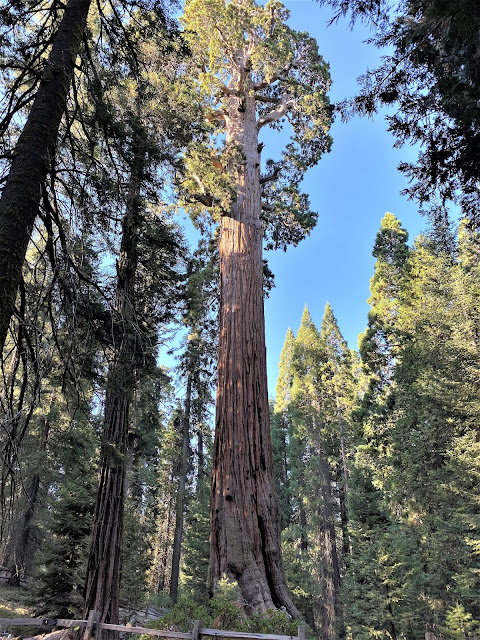









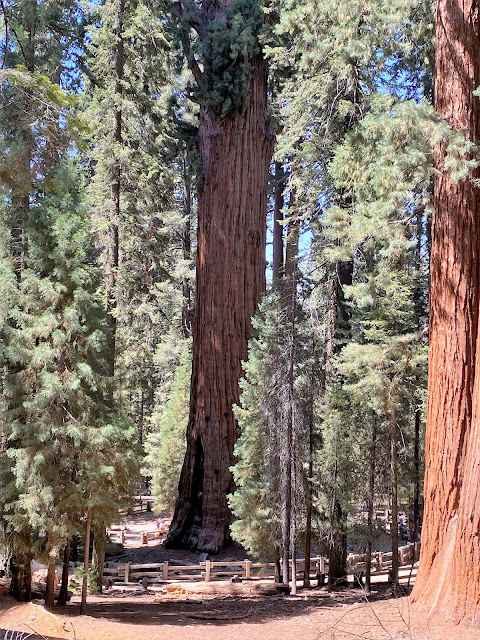














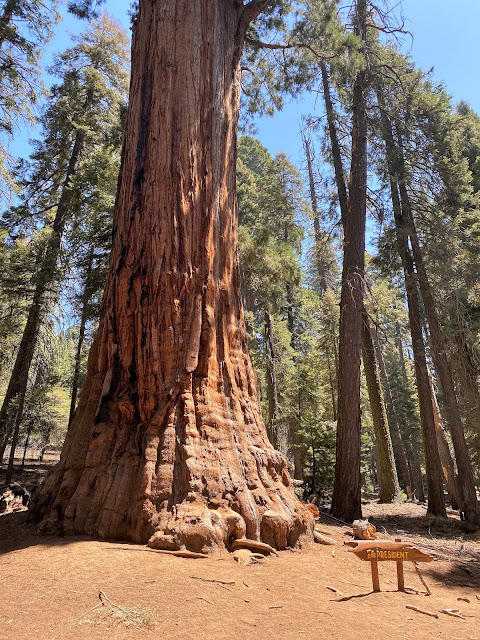


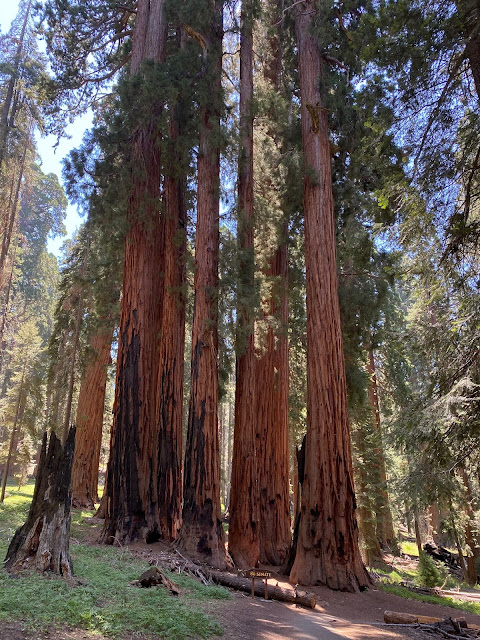







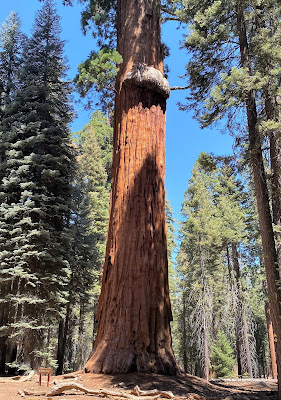


I had no idea that the President tree was the third largest tree in the world and the oldest. I too, think it was my favorite. It and the Senate and Congress were my favorite area of Sequoia. I just read that a huge storm in Sequoia blew over 15 sequoia trees, none of them named trees, but a tragedy never-the-less.
ReplyDelete